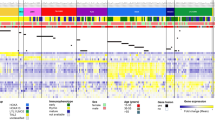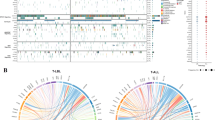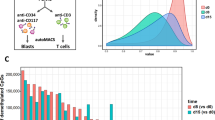Abstract
TAL1 is one of the most frequently dysregulated oncogenes in T-cell Acute Lymphoblastic Leukaemia (T-ALL). However, the precise frequency and prognostic impact associated with its dysregulation remains unclear and is confounded by TAL1’s diverse dysregulation mechanisms. TAL1 dysregulation is detected by TAL1 transcript quantification, though this technique may be subject to interference by TAL1 transcripts deriving from residual haematological cells that physiologically express high levels of the gene. We hypothesised TAL1 DNA methylation could provide a more reliable biomarker than TAL1 transcript quantification alone. We extensively studied TAL1 dysregulation in a large adult and paediatric T-ALL cohort (n = 401) and designed a TAL1 specific MS-MLPA assay to determine methylation levels. Whereas monoallelic TAL1 + T-ALL had homogeneous gene expression profiles, never expressed other driver oncogenes and were TAL1 hypomethylated (methylation ratio <0.4), biallelic TAL1 + T-ALL were enriched in expression of other driver oncogenes (TLX1, TLX3, HOXA), and had heterogeneous transcriptomes and TAL1 methylation levels. In PDX analysis, monoallelic TAL1 expression was stable, contrary to biallelic expression which mostly derived from residual non-malignant haematopoietic cells. Importantly, we report 5 novel TAL1 dysregulation mechanisms using long-read nanopore and OGM analysis, and show that TAL1 hypomethylation identifies TAL1 dysregulation, and is associated with worse prognosis.
This is a preview of subscription content, access via your institution
Access options
Subscribe to this journal
Receive 12 print issues and online access
$259.00 per year
only $21.58 per issue
Buy this article
- Purchase on SpringerLink
- Instant access to full article PDF
Prices may be subject to local taxes which are calculated during checkout






Similar content being viewed by others
Data availability
For EPIC data, all microarray raw IDAT files have been deposited to Gene Expression Omnibus (GEO) under the accession number GSE147667 as detailed in [29].
References
Green AR, Lints T, Visvader J, Harvey R, Begley CG. SCL is coexpressed with GATA-1 in hemopoietic cells but is also expressed in developing brain. Oncogene. 1992;7:653–60.
Pulford K, Lecointe N, Leroy-Viard K, Jones M, Mathieu-Mahul D, Mason DY. Expression of TAL-1 proteins in human tissues. Blood. 1995;85:675–84.
Green AR, Salvaris E, Begley CG. Erythroid expression of the ‘helix-loop-helix’ gene, SCL. Oncogene. 1991;6:475–9.
Mouthon M-A, Bernard O, Mitjavila M-T, Romeo P-H, Vainchenker W, Mathieu-Mahul D. Expression of tal-I and GATA-binding proteins during human hematopoiesis. Blood. 1993;81:647–55.
Herblot S, Steff A-M, Hugo P, Aplan PD, Hoang T. SCL and LMO1 alter thymocyte differentiation: inhibition of E2A-HEB function and pre-Tα chain expression. Nat Immunol. 2000;1:138–44.
Zhang Y, Payne KJ, Zhu Y, Price MA, Parrish YK, Zielinska E, et al. SCL expression at critical points in human hematopoietic lineage commitment. Stem Cells. 2005;23:852–60.
Navarro J-M, Touzart A, Pradel LC, Loosveld M, Koubi M, Fenouil R, et al. Site- and allele-specific polycomb dysregulation in T-cell leukaemia. Nat Commun. 2015;6:6094.
Ferrando AA, Neuberg DS, Staunton J, Loh ML, Huard C, Raimondi SC, et al. Gene expression signatures define novel oncogenic pathways in T cell acute lymphoblastic leukemia. Cancer Cell. 2002;1:75–87.
Soulier J, Clappier E, Cayuela JM, Regnault A, García-Peydró M, Dombret H, et al. HOXA genes are included in genetic and biologic networks defining human acute T-cell leukemia (T-ALL). Blood. 2005;106:274–86.
Homminga I, Vuerhard MJ, Langerak AW, Buijs-Gladdines J, Pieters R, Meijerink JPP. Characterization of a pediatric T-cell acute lymphoblastic leukemia patient with simultaneous LYL1 and LMO2 rearrangements. Haematologica. 2012;97:258–61.
Delabesse E, Bernard M, Meyer V, Smit L, Pulford K, Cayuela J-M, et al. TAL1 expression does not occur in the majority of T-ALL blasts. Br J Haematol. 1998;102:449–57.
Ferrando AA, Herblot S, Palomero T, Hansen M, Hoang T, Fox EA, et al. Biallelic transcriptional activation of oncogenic transcription factors in T-cell acute lymphoblastic leukemia. Blood. 2004. https://doi.org/10.1182/blood-2003-07-2577.
Bash RO, Hall S, Timmons CF, Crist WM, Amylon M, Smith RG, et al. Does activation of the TAL1 gene occur in a majority of patients with T-cell acute lymphoblastic leukemia? A pediatric oncology group study. Blood. 1995;86:666–76.
van Grotel M, Meijerink JP, Beverloo HB, Langerak AW, Buys-Gladdines JG, Schneider P, et al. The outcome of molecular-cytogenetic subgroups in pediatric T-cell acute lymphoblastic leukemia: a retrospective study of patients treated according to DCOG or COALL protocols. Haematologica. 2006;91:1212–21.
Bash BR, Hall S, Timmons CF, Crist WM, Amylon M, Smith RG, et al. Does activation of the TALl gene occur in a majority of patients with T-cell acute lymphoblastic leukemia? a pediatric oncology group study. Blood J. 1995;2:666–76.
Brown L, Cheng JT, Chen Q, Siciliano MJ, Crist W, Buchanan G, et al. Site-specific recombination of the tal-1 gene is a common occurrence in human T cell leukemia. EMBO J. 1990;9:3343–51.
Begley CG, Aplan PD, Davey MP, Nakahara K, Tchorz K, Kurtzberg J, et al. Chromosomal translocation in a human leukemic stem-cell line disrupts the T-cell antigen receptor delta-chain diversity region and results in a previously unreported fusion transcript. Proc Natl Acad Sci USA. 1989;86:2031–5.
Cauwelier B, Dastugue N, Cools J, Poppe B, Herens C, De Paepe A, et al. Molecular cytogenetic study of 126 unselected T-ALL cases reveals high incidence of TCRβ locus rearrangements and putative new T-cell oncogenes. Leukemia. 2006;20:1238–44.
Le Noir S, Ben Abdelali R, Lelorch M, Bergeron J, Sungalee S, Payet-Bornet D, et al. Extensive molecular mapping of TCRα/δ- and TCRβ-involved chromosomal translocations reveals distinct mechanisms of oncogene activation in T-ALL. Blood. 2012;120:3298–309.
Mansour MR, Abraham BJ, Anders L, Berezovskaya A, Gutierrez A, Durbin AD, et al. Oncogene regulation. An oncogenic super-enhancer formed through somatic mutation of a noncoding intergenic element. Science (80-). 2014;346:1373–7.
Smith C, Goyal A, Weichenhan D, Allemand E, Mayakonda A, Toprak U, et al. TAL1 activation in T-Cell acute lymphoblastic leukemia: A novel oncogenic 3’ neoenhancer. 2023 https://doi.org/10.3324/haematol.2022.281583.
Liu Y, Li C, Shen S, Chen X, Szlachta K, Edmonson MN, et al. Discovery of regulatory noncoding variants in individual cancer genomes by using cis-X. Nat Genet. 2020;52:811–8.
Borssén M, Palmqvist L, Karrman K, Abrahamsson J, Behrendtz M, Heldrup J, et al. Promoter DNA Methylation Pattern Identifies Prognostic Subgroups in Childhood T-Cell Acute Lymphoblastic Leukemia. PLoS One. 2013;8:e65373.
Borssén M, Haider Z, Landfors M, Norén-Nyström U, Schmiegelow K, Åsberg AE, et al. DNA methylation adds prognostic value to minimal residual disease status in pediatric T-cell acute lymphoblastic leukemia. Pediatr Blood Cancer. 2016;63:1185–92.
Berman BP, Weisenberger DJ, Aman JF, Hinoue T, Ramjan Z, Liu Y, et al. Regions of focal DNA hypermethylation and long-range hypomethylation in colorectal cancer coincide with nuclear lamina–associated domains. Nat Genet. 2012;44:40–46.
Gaudet F, Hodgson JG, Eden A, Jackson-Grusby L, Dausman J, Gray JW, et al. Induction of Tumors in Mice by Genomic Hypomethylation. Science (80-). 2003;300:489–92.
Hon GC, Hawkins RD, Caballero OL, Lo C, Lister R, Pelizzola M, et al. Global DNA hypomethylation coupled to repressive chromatin domain formation and gene silencing in breast cancer. Genome Res. 2012;22:246–58.
Bender S, Tang Y, Lindroth AM, Hovestadt V, Jones DTW, Kool M, et al. Reduced H3K27me3 and DNA Hypomethylation Are Major Drivers of Gene Expression in K27M Mutant Pediatric High-Grade Gliomas. Cancer Cell. 2013;24:660–72.
Touzart A, Mayakonda A, Smith C, Hey J, Toth R, Cieslak A, et al. Epigenetic analysis of patients with T-ALL identifies poor outcomes and a hypomethylating agent-responsive subgroup. Sci Transl Med. 2021;13:1–16.
Petit A, Trinquand A, Chevret S, Ballerini P, Cayuela J-M, Grardel N, et al. Oncogenetic mutations combined with MRD improve outcome prediction in pediatric T-cell acute lymphoblastic leukemia. Blood. 2018;131:289–300.
Asnafi V, Beldjord K, Boulanger E, Comba B, Le Tutour P, Estienne M-H, et al. Analysis of TCR, pTα, and RAG-1 in T-acute lymphoblastic leukemias improves understanding of early human T-lymphoid lineage commitment. Blood. 2003;101:2693–703.
Bergeron J, Clappier E, Radford I, Buzyn A, Millien C, Soler G, et al. Prognostic and oncogenic relevance of TLX1/HOX11 expression level in T-ALLs. Blood. 2007;110:2324–30.
Asnafi V, Buzyn A, Le Noir S, Baleydier F, Simon A, Beldjord K, et al. NOTCH1/FBXW7 mutation identifies a large subgroup with favorable outcome in adult T-cell acute lymphoblastic leukemia (T-ALL): A Group for Research on Adult Acute Lymphoblastic Leukemia (GRAALL) study. Blood. 2009;113:3918–24.
Bond J, Marchand T, Touzart A, Cieslak A, Trinquand A, Sutton L, et al. An early thymic precursor phenotype predicts outcome exclusively in HOXA-overexpressing adult T-cell acute lymphoblastic leukemia: a Group for Research in Adult Acute Lymphoblastic Leukemia study. Haematologica. 2016;101:732–40.
Jeuken JWM, Cornelissen SJB, Vriezen M, Dekkers MMG, Errami A, Sijben A, et al. MS-MLPA: an attractive alternative laboratory assay for robust, reliable, and semiquantitative detection of MGMT promoter hypermethylation in gliomas. Lab Investig. 2007;87:1055–65.
Balducci E, Kaltenbach S, Villarese P, Duroyon E, Zalmai L, Friedrich C, et al. Optical genome mapping refines cytogenetic diagnostics, prognostic stratification and provides new molecular insights in adult MDS/AML patients. Blood Cancer J. 2022;12:126.
Bornschein S, Demeyer S, Stirparo R, Gielen O, Vicente C, Geerdens E, et al. Defining the molecular basis of oncogenic cooperation between TAL1 expression and Pten deletion in T-ALL using a novel pro-T-cell model system. Leukemia. 2018;32:941–51.
Sanda T, Lawton LN, Barrasa MI, Fan ZP, Kohlhammer H, Gutierrez A, et al. Core transcriptional regulatory circuit controlled by the TAL1 complex in human T cell acute lymphoblastic leukemia. Cancer Cell. 2012;22:209–21.
Allen JD, Lints T, Jenkins NA, Copeland NG, Strasser A, Harvey RP, et al. Novel murine homeo box gene on chromosome 1 expressed in specific hematopoietic lineages and during embryogenesis. Genes Dev. 1991;5:509–20.
Malumbres R, Fresquet V, Roman-Gomez J, Bobadilla M, Robles EF, Altobelli GG, et al. LMO2 expression reflects the different stages of blast maturation and genetic features in B-cell acute lymphoblastic leukemia and predicts clinical outcome. Haematologica. 2011;96:980–6.
Kikuchi A, Hayashi Y, Kobayashi S, Hanada R, Moriwaki K, Yamamoto K, et al. Clinical significance of TAL1 gene alteration in childhood T-cell acute lymphoblastic leukemia and lymphoma. Leukemia. 1993;7:933–8.
Wang D, Zhu G, Wang N, Zhou X, Yang Y, Zhou S, et al. SIL-TAL1 rearrangement is related with poor outcome: a study from a Chinese institution. PLoS One. 2013; 8. https://doi.org/10.1371/journal.pone.0073865.
D’Angiò M, Valsecchi MG, Testi AM, Conter V, Nunes V, Parasole R, et al. Clinical features and outcome of SIL/TAL1-positive T-cell acute lymphoblastic leukemia in children and adolescents: a 10-year experience of the AIEOP group. Haematologica. 2015;100:e10–e13.
Hao X, Luo H, Krawczyk M, Wei W, Wang W, Wang J, et al. DNA methylation markers for diagnosis and prognosis of common cancers. Proc Natl Acad Sci. 2017;114:7414 LP–7419.
Nygren AOH, Ameziane N, Duarte HMB, Vijzelaar RNCP, Waisfisz Q, Hess CJ, et al. Methylation-specific MLPA (MS-MLPA): simultaneous detection of CpG methylation and copy number changes of up to 40 sequences. Nucleic Acids Res. 2005;33:e128.
Acknowledgements
We would like to thank all participants in the GRAALL-2003 and GRAALL-2005 study groups, the SFCE and the investigators of the 16 SFCE centres involved in collection and provision of data and patient samples, and V. Lheritier for collection of clinical data.
Funding
The GRAALL was supported by grants P0200701 and P030425/AOM03081 from the Programme Hospitalier de Recherche Clinique, Ministère de l’Emploi et de la Solidarité, France and the Swiss Federal Government in Switzerland. Samples were collected and processed by the AP-HP “Direction de Recherche Clinique” Tumour Bank at Necker-Enfants Malades. We would also like to thank La Fondation pour la Recherche Médicale for their support through the grant FDT202012010638 which was awarded to CS and “La Ligue Contre le Cancer” for supporting MS.
Author information
Authors and Affiliations
Contributions
CS designed and carried out experiments, visualised data, and wrote the original manuscript, GC carried out RNA-seq bioinformatic analysis and visualised the data. MS analysed and visualised clinical data. EB analysed and visualised OGM data. TS processed, analysed, and visualised WGS data. GA analysed and visualised NGS data. MLL, ML, and ALN carried out experiments. VA and AT offered expertise and supervised the research. CS, GC, MS, EB, TS, GA, AC, MC, MLL, AM, CP, ALN, ML, NI, HD, FH, AB, EM, AP, NB, VA, and AT all critically reviewed and approved the final manuscript.
Corresponding authors
Ethics declarations
Competing interests
The authors declare no competing interests.
Ethics approval and consent to participate
Both adult and paediatric trials included in this study were conducted in accordance with the Declaration of Helsinki and approved by local and multicentre research ethical committees. Consent was obtained from all patients at trial entry. Animal experimentation was evaluated and approved by the Institute’s ethics committee and the Ministère de l’enseignement supérieur de la recherche et de l’innovation.
Additional information
Publisher’s note Springer Nature remains neutral with regard to jurisdictional claims in published maps and institutional affiliations.
Supplementary information
Rights and permissions
Springer Nature or its licensor (e.g. a society or other partner) holds exclusive rights to this article under a publishing agreement with the author(s) or other rightsholder(s); author self-archiving of the accepted manuscript version of this article is solely governed by the terms of such publishing agreement and applicable law.
About this article
Cite this article
Smith, C., Charbonnier, G., Simonin, M. et al. Towards methylation-based redefinition of TAL1 positive T-cell acute lymphoblastic leukaemia (T-ALL). Leukemia 39, 2344–2354 (2025). https://doi.org/10.1038/s41375-025-02714-3
Received:
Revised:
Accepted:
Published:
Issue date:
DOI: https://doi.org/10.1038/s41375-025-02714-3



